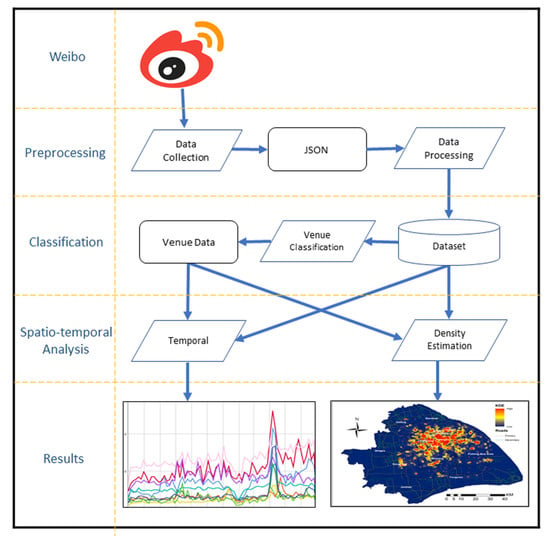A Study of User Activity Patterns and the Effect of Venue Types on City Dynamics Using Location-Based Social Network Data
Abstract
:1. Introduction
- Hourly, weekly and daily based (the study period of total 365 days) temporal [16].
- Classification of the dataset and study 10 venue categories [17].
- Spatial analysis for modeling and density estimation of each category for better understanding of typical check-in concentrations based on each venue category, demonstrating the role of venues in the diversity of users in Shanghai.
2. Literature Review
3. Dataset and Methodology
3.1. Study Area and Datasource
3.2. Data Collection and Preprocessing
3.3. Analysis Framwork
4. Results and Discussion
4.1. Temporal Analysis
4.2. Check-in Venue Categorization
4.3. Density Estimation
5. Conclusions
Author Contributions
Funding
Conflicts of Interest
Data Availability
References
- Singh, R.; Zhang, Y.; Wang, H. Exploring human mobility patterns in Melbourne using social media data. In Proceedings of the Australasian Database Conference, Gold Coast, Australia, 24–27 May 2018; Springer: Cham, Switzerland, 2018; pp. 328–335. [Google Scholar]
- Alrumayyan, N.; Bawazeer, S.; AlJurayyad, R.; Al-Razgan, M. Analyzing User Behaviors: A Study of Tips in Foursquare. In Proceedings of the 5th International Symposium on Data Mining Applications, Riyadh, Saudi Arabia, 21–22 March 2018; Springer: Cham, Switzerland, 2018; pp. 153–168. [Google Scholar]
- Noulas, A.; Scellato, S.; Mascolo, C.; Pontil, M. An empirical study of geographic user activity patterns in foursquare. In Proceedings of the Fifth International AAAI Conference on Weblogs and Social Media, Barcelona, Spain, 17–21 July 2011. [Google Scholar]
- Hollenstein, L.; Purves, R. Exploring place through user-generated content: Using Flickr tags to describe city cores. J. Spat. Inf. Sci. 2010, 1, 21–48. [Google Scholar]
- Preston, J.; Stelter, B. How Government Officials Are Using Twitter for Hurricane Sandy. The New York Times, 2 November 2012. [Google Scholar]
- Weibo. Available online: http://www.weibo.com (accessed on 2 September 2020).
- Wang, B.; Zhen, F.; Wei, Z.; Guo, S.; Chen, T. A theoretical framework and methodology for urban activity spatial structure in e-society: Empirical evidence for Nanjing City, China. Chin. Geogr. Sci. 2015, 25, 672–683. [Google Scholar] [CrossRef]
- Bo, W.; Feng, Z.; Zongcai, W. The research on characteristics of urban activity space in Nanjing: An empirical analysis based on big data. Hum. Geogr. 2014, 29, 14–21. [Google Scholar]
- Todd, A.W.; Campbell, A.L.; Meyer, G.G.; Horner, R.H. The effects of a targeted intervention to reduce problem behaviors: Elementary school implementation of check in—Check out. J. Posit. Behav. Interv. 2008, 10, 46–55. [Google Scholar] [CrossRef]
- Zhen, F.; Cao, Y.; Qin, X.; Wang, B. Delineation of an urban agglomeration boundary based on Sina Weibo microblog ‘check-in’ data: A case study of the Yangtze River Delta. Cities 2017, 60, 180–191. [Google Scholar] [CrossRef]
- Loo, B.P.; Yao, S.; Wu, J. Spatial point analysis of road crashes in Shanghai: A GIS-based network kernel density method. In Proceedings of the 19th International Conference on Geoinformatics, Shanghai, China, 24–26 June 2011; pp. 1–6. [Google Scholar]
- Gu, Z.; Zhang, Y.; Chen, Y.; Chang, X. Analysis of attraction features of tourism destinations in a mega-city based on check-in data mining—A case study of ShenZhen, China. ISPRS Int. J. Geo-Inf. 2016, 5, 210. [Google Scholar] [CrossRef] [Green Version]
- Long, Y.; Han, H.; Tu, Y.; Shu, X. Evaluating the effectiveness of urban growth boundaries using human mobility and activity records. Cities 2015, 46, 76–84. [Google Scholar] [CrossRef]
- Lei, C.; Zhang, A.; Qi, Q.; Su, H.; Wang, J. Spatial-temporal analysis of human dynamics on urban land use patterns using social media data by gender. ISPRS Int. J. Geo-Inf. 2018, 7, 358. [Google Scholar] [CrossRef] [Green Version]
- Preoţiuc-Pietro, D.; Cohn, T. Mining user behaviours: A study of check-in patterns in location based social networks. In Proceedings of the 5th Annual ACM Web Science Conference, Paris, France, 2–4 May 2013; pp. 306–315. [Google Scholar]
- Khan, N.U.; Wan, W.; Yu, S. Location-based social network’s data analysis and spatio-temporal modeling for the mega city of Shanghai, China. ISPRS Int. J. Geo-Inf. 2020, 9, 76. [Google Scholar] [CrossRef] [Green Version]
- Khan, N.U.; Wan, W.; Yu, S. Spatiotemporal analysis of tourists and residents in Shanghai based on location-based social network’s data from Weibo. ISPRS Int. J. Geo-Inf. 2020, 9, 70. [Google Scholar] [CrossRef] [Green Version]
- Lohr, S. Big Data Is Opening Doors, but Maybe too Many. The New York Times, 24 March 2013; Volume 23. [Google Scholar]
- Chatterjee, P. Big Data: The Greater Good or Invasion of Privacy. Guardian, 12 March 2013; Volume 12. [Google Scholar]
- Ward, J.S.; Barker, A. Undefined by data: A survey of big data definitions. arXiv 2013, arXiv:1309.5821. [Google Scholar]
- Dumbill, E. What Is Big Data? An Introduction to the Big Data Landscape. 2012. Available online: http://radar.oreilly.com/2012/01/what-is-big-data.html (accessed on 19 November 2020).
- Mayer-Schönberger, V.; Cukier, K. Big Data: A Revolution that Will Transform How We Live, Work, and Think; Houghton Mifflin Harcourt: Boston, MA, USA, 2013. [Google Scholar]
- Miller, H.J.; Goodchild, M.F. Data-driven geography. GeoJournal 2015, 80, 449–461. [Google Scholar] [CrossRef]
- Ovadia, S. The role of big data in the social sciences. Behav. Soc. Sci. Libr. 2013, 32, 130–134. [Google Scholar] [CrossRef]
- Yanwei, C.; Yue, S.; Zuopeng, X.; Yan, Z.; Ying, Z.; Na, T. Review for space-time behavior research: Theory frontiers and application in the future. Prog. Geogr. 2012, 31, 667–675. [Google Scholar]
- Kwan, M.-P.; Lee, J. Geovisualization of human activity patterns using 3D GIS: A time-geographic approach. Spat. Integr. Soc. Sci. 2004, 27, 721–744. [Google Scholar]
- Polak, J.; Jones, P. The acquisition of pre-trip information: A stated preference approach. Transp. Res. Part C Emerg. Technol. 1993, 20, 179–198. [Google Scholar] [CrossRef]
- Che, Q.; Duan, X.; Guo, Y.; Wang, L.; Cao, Y. Urban spatial expansion process, pattern and mechanism in Yangtze River Delta. Acta Geogr. Sin. 2011, 66, 446–456. [Google Scholar]
- Graham, M.; Shelton, T. Geography and the future of big data, big data and the future of geography. Dialogues Hum. Geogr. 2013, 3, 255–261. [Google Scholar] [CrossRef] [Green Version]
- Gonzalez, M.C.; Hidalgo, C.A.; Barabasi, A.-L. Understanding individual human mobility patterns. Nature 2008, 453, 779. [Google Scholar] [CrossRef]
- Song, C.; Qu, Z.; Blumm, N.; Barabási, A.-L. Limits of predictability in human mobility. Science 2010, 327, 1018–1021. [Google Scholar] [CrossRef] [Green Version]
- Zhu, X. GIS and urban mining. Resources 2014, 3, 235–247. [Google Scholar] [CrossRef]
- Yuan, J.; Zheng, Y.; Xie, X. Discovering regions of different functions in a city using human mobility and POIs. In Proceedings of the 18th ACM SIGKDD International Conference on Knowledge Discovery and Data Mining, Beijing, China, 12–16 August 2012; pp. 186–194. [Google Scholar]
- Wesolowski, A.; Qureshi, T.; Boni, M.F.; Sundsøy, P.R.; Johansson, M.A.; Rasheed, S.B.; Engø-Monsen, K.; Buckee, C.O. Impact of human mobility on the emergence of dengue epidemics in Pakistan. Proc. Natl. Acad. Sci. USA 2015, 112, 11887–11892. [Google Scholar] [CrossRef] [PubMed] [Green Version]
- Pappalardo, L.; Simini, F.; Rinzivillo, S.; Pedreschi, D.; Giannotti, F.; Barabási, A.-L. Returners and explorers dichotomy in human mobility. Nat. Commun. 2015, 6, 8166. [Google Scholar] [CrossRef] [PubMed] [Green Version]
- Fan, C.; Liu, Y.; Huang, J.; Rong, Z.; Zhou, T. Correlation between social proximity and mobility similarity. Sci. Rep. 2017, 7, 11975. [Google Scholar] [CrossRef] [Green Version]
- Chen, H.; Chiang, R.H.; Storey, V.C. Business intelligence and analytics: From big data to big impact. MIS Q. 2012, 36, 1165–1188. [Google Scholar] [CrossRef]
- Wixom, B.; Watson, H. The BI-based organization. Int. J. Bus. Intell. Res. 2010, 1, 13–28. [Google Scholar] [CrossRef]
- Wieder, B.; Ossimitz, M.-L. The impact of Business Intelligence on the quality of decision making—A mediation model. Procedia Comput. Sci. 2015, 64, 1163–1171. [Google Scholar] [CrossRef] [Green Version]
- Grublješič, T.; Jaklič, J. Conceptualization of the business intelligence extended use model. J. Comput. Inf. Syst. 2015, 55, 72–82. [Google Scholar] [CrossRef]
- Yoon, T.E.; Ghosh, B.; Jeong, B.-K. User acceptance of business intelligence (BI) application: Technology, individual difference, social influence, and situational constraints. In Proceedings of the 47th Hawaii International Conference on System Sciences, Waikoloa, HI, USA, 6–9 January 2014; pp. 3758–3766. [Google Scholar]
- Clark, T.D.; Jones, M.C.; Armstrong, C.P. The dynamic structure of management support systems: Theory development, research focus, and direction. MIS Q. 2007, 31, 579–615. [Google Scholar] [CrossRef]
- Bach, M.P.; Čeljo, A.; Zoroja, J. Technology acceptance model for business intelligence systems: Preliminary research. Procedia Comput. Sci. 2016, 100, 995–1001. [Google Scholar] [CrossRef] [Green Version]
- Singh, Y.S.; Singh, Y.K.; Devi, N.S.; Singh, Y.J. Easy designing steps of a local data warehouse for possible analytical data processing. Adbu J. Eng. Technol. 2019, 8. [Google Scholar]
- Santos, V.; Silva, R.; Belo, O. Towards a low cost ETL system. Int. J. Database Manag. Syst. 2014, 6, 67. [Google Scholar] [CrossRef]
- Cheng, C.; Jain, R.; van den Berg, E. Location prediction algorithms for mobile wireless systems. In Proceedings of Wireless Internet Handbook; ACM: New York, NY, USA, 2003; pp. 245–263. [Google Scholar]
- Cho, E.; Myers, S.A.; Leskovec, J. Friendship and mobility: User movement in location-based social networks. In Proceedings of the 17th ACM SIGKDD International Conference on Knowledge Discovery and Data Mining, San Diego, CA, USA, 12 August 2011; pp. 1082–1090. [Google Scholar]
- Gao, H.; Tang, J.; Liu, H. Exploring social-historical ties on location-based social networks. In Proceedings of the Sixth International AAAI Conference on Weblogs and Social Media, Dublin, Ireland, 4–7 June 2012. [Google Scholar]
- Lindqvist, J.; Cranshaw, J.; Wiese, J.; Hong, J.; Zimmerman, J. I’m the mayor of my house: Examining why people use foursquare-a social-driven location sharing application. In Proceedings of the SIGCHI Conference on Human Factors in Computing Systems, Vancouver, BC, Canada, 7 May 2011; pp. 2409–2418. [Google Scholar]
- Scellato, S.; Noulas, A.; Lambiotte, R.; Mascolo, C. Socio-spatial properties of online location-based social networks. In Proceedings of the Fifth International AAAI Conference on Weblogs and Social Media, Barcelona, Spain, 17–21 July 2011. [Google Scholar]
- Zhang, J.-D.; Chow, C.-Y. iGSLR: Personalized geo-social location recommendation: A kernel density estimation approach. In Proceedings of the 21st ACM SIGSPATIAL International Conference on Advances in Geographic Information Systems, Orlando, FL, USA, 5–8 November 2013; pp. 334–343. [Google Scholar]
- Colombo, G.B.; Chorley, M.J.; Williams, M.J.; Allen, S.M.; Whitaker, R.M. You are where you eat: Foursquare checkins as indicators of human mobility and behaviour. In Proceedings of the 2012 IEEE International Conference on Pervasive Computing and Communications Workshops, Lugano, Switzerland, 19–23 March 2012; pp. 217–222. [Google Scholar]
- Li, Y.; Steiner, M.; Wang, L.; Zhang, Z.-L.; Bao, J. Exploring venue popularity in foursquare. In Proceedings of the 2013 IEEE INFOCOM, Turin, Italy, 14–19 April 2013; pp. 3357–3362. [Google Scholar]
- Lin, S.; Xie, R.; Xie, Q.; Zhao, H.; Chen, Y. Understanding user activity patterns of the swarm app: A data-driven study. In Proceedings of the 2017 ACM International Joint Conference on Pervasive and Ubiquitous Computing and Proceedings of the 2017 ACM International Symposium on Wearable Computers; ACM: New York, NY, USA, 2017; pp. 125–128. [Google Scholar]
- Shi, B.; Zhao, J.; Chen, P.-J. Exploring urban tourism crowding in Shanghai via crowdsourcing geospatial data. Curr. Issues Tour. 2017, 20, 1186–1209. [Google Scholar] [CrossRef]
- Rizwan, M.; Wan, W.; Cervantes, O.; Gwiazdzinski, L. Using location-based social media data to observe check-in behavior and gender difference: Bringing weibo data into play. ISPRS Int. J. Geo-Inf. 2018, 7, 196. [Google Scholar] [CrossRef] [Green Version]
- Rizwan, M.; Wan, W. Big data analysis to observe check-in behavior using location-based social media data. Information 2018, 9, 257. [Google Scholar] [CrossRef] [Green Version]
- Rizwan, M.; Mahmood, S.; Wanggen, W.; Ali, S. Location based social media data analysis for observing check-in behavior and city rhythm in Shanghai. In Proceedings of the 4th International Conference on Smart and Sustainable City (ICSSC 2017), Shanghai, China, 5–6 June 2017. [Google Scholar]
- Wu, C.; Ye, X.; Ren, F.; Du, Q.J.C. Check-in behaviour and spatio-temporal vibrancy: An exploratory analysis in Shenzhen, China. Cities 2018, 77, 104–116. [Google Scholar] [CrossRef]
- Wu, J.; Li, J.; Ma, Y.J.I.I.J.o.G.-I. A comparative study of spatial and temporal preferences for waterfronts in Wuhan based on gender differences in check-in behavior. ISPRS Int. J. Geo-Inf. 2019, 8, 413. [Google Scholar] [CrossRef] [Green Version]
- Muhammad, R.; Zhao, Y.; Liu, F.J.S. Spatiotemporal analysis to observe gender based check-in behavior by using social media big data: A case study of Guangzhou, China. Sustainability 2019, 11, 2822. [Google Scholar] [CrossRef] [Green Version]
- Liu, C.Y.; Chen, J.; Li, H. Linking migrant enclave residence to employment in urban China: The case of Shanghai. J. Urban Aff. 2019, 41, 189–205. [Google Scholar] [CrossRef] [Green Version]
- Zhang, Y.; Li, X.; Wang, A.; Bao, T.; Tian, S. Density and diversity of OpenStreetMap road networks in China. J. Urban Manag. 2015, 4, 135–146. [Google Scholar] [CrossRef] [Green Version]
- ArcGIS. How Kernel Density Works. Available online: https://pro.arcgis.com/en/pro-app/tool-reference/spatial-analyst/how-kernel-density-works.htm (accessed on 4 November 2020).
- Zhang, J.; Wu, L. The influence of population movements on the urban relative humidity of Beijing during the Chinese Spring Festival holiday. J. Clean. Prod. 2018, 170, 1508–1513. [Google Scholar] [CrossRef]
- Hasan, S.; Zhan, X.; Ukkusuri, S.V. Understanding urban human activity and mobility patterns using large-scale location-based data from online social media. In Proceedings of the 2nd ACM SIGKDD International Workshop on Urban Computing, Chicago, IL, USA, 11 August 2013; p. 6. [Google Scholar]
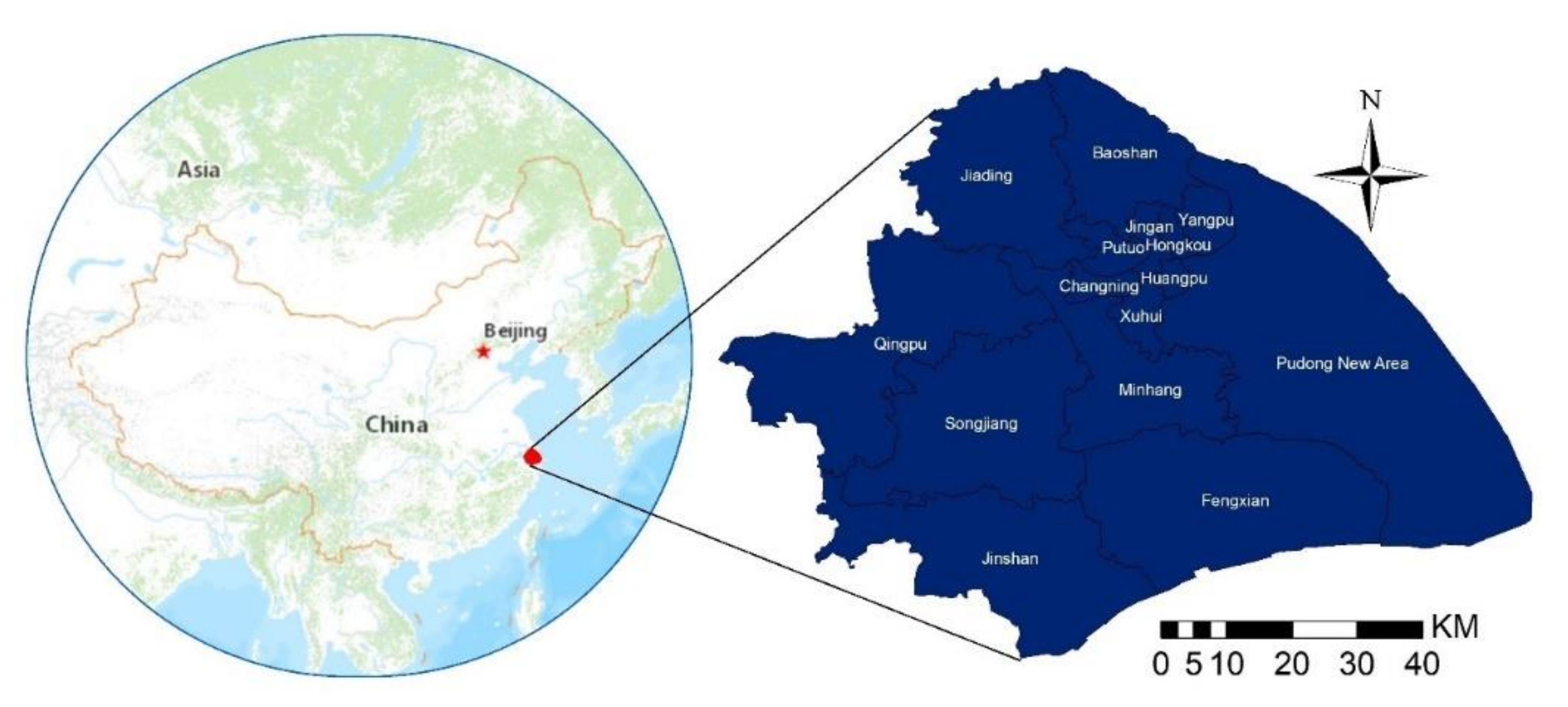

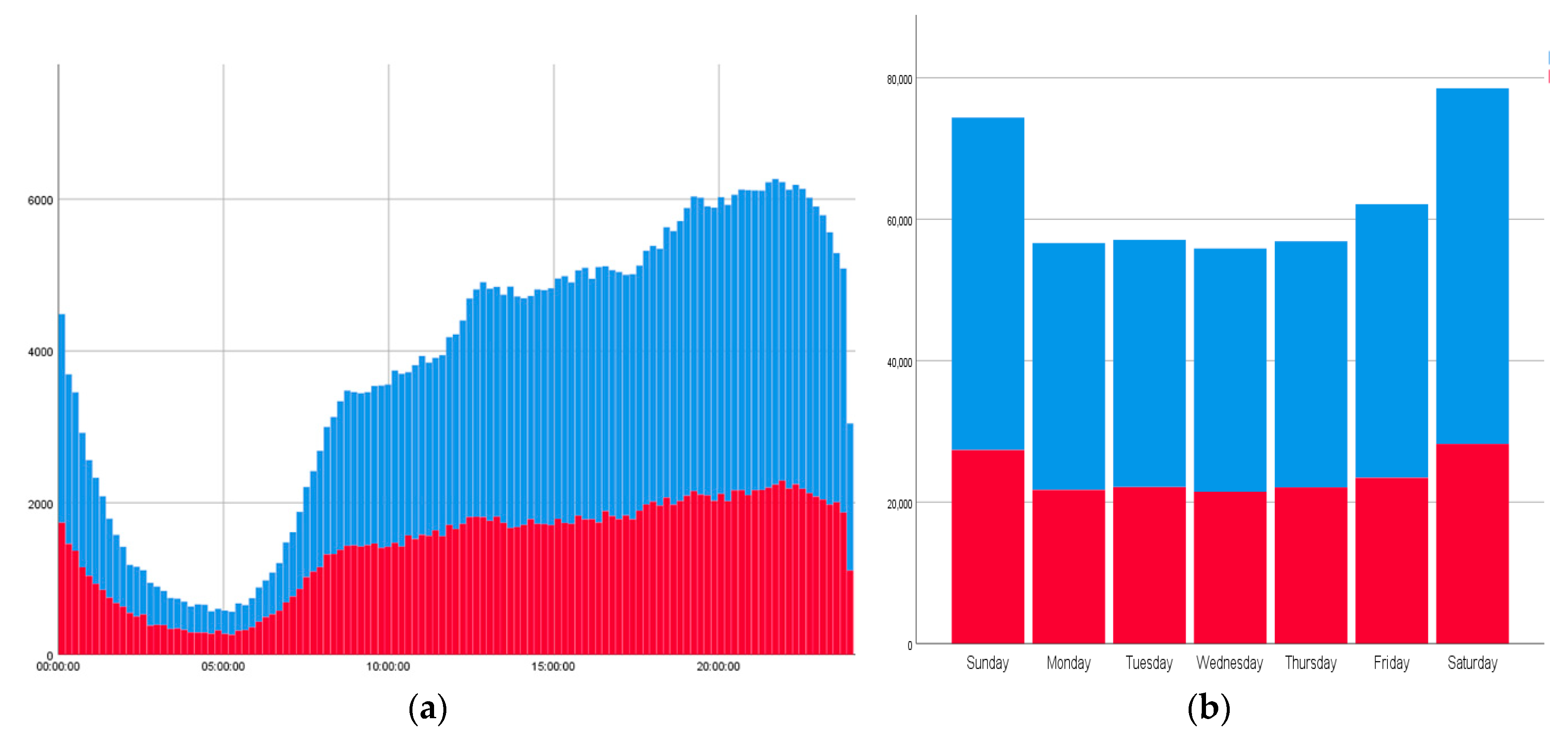

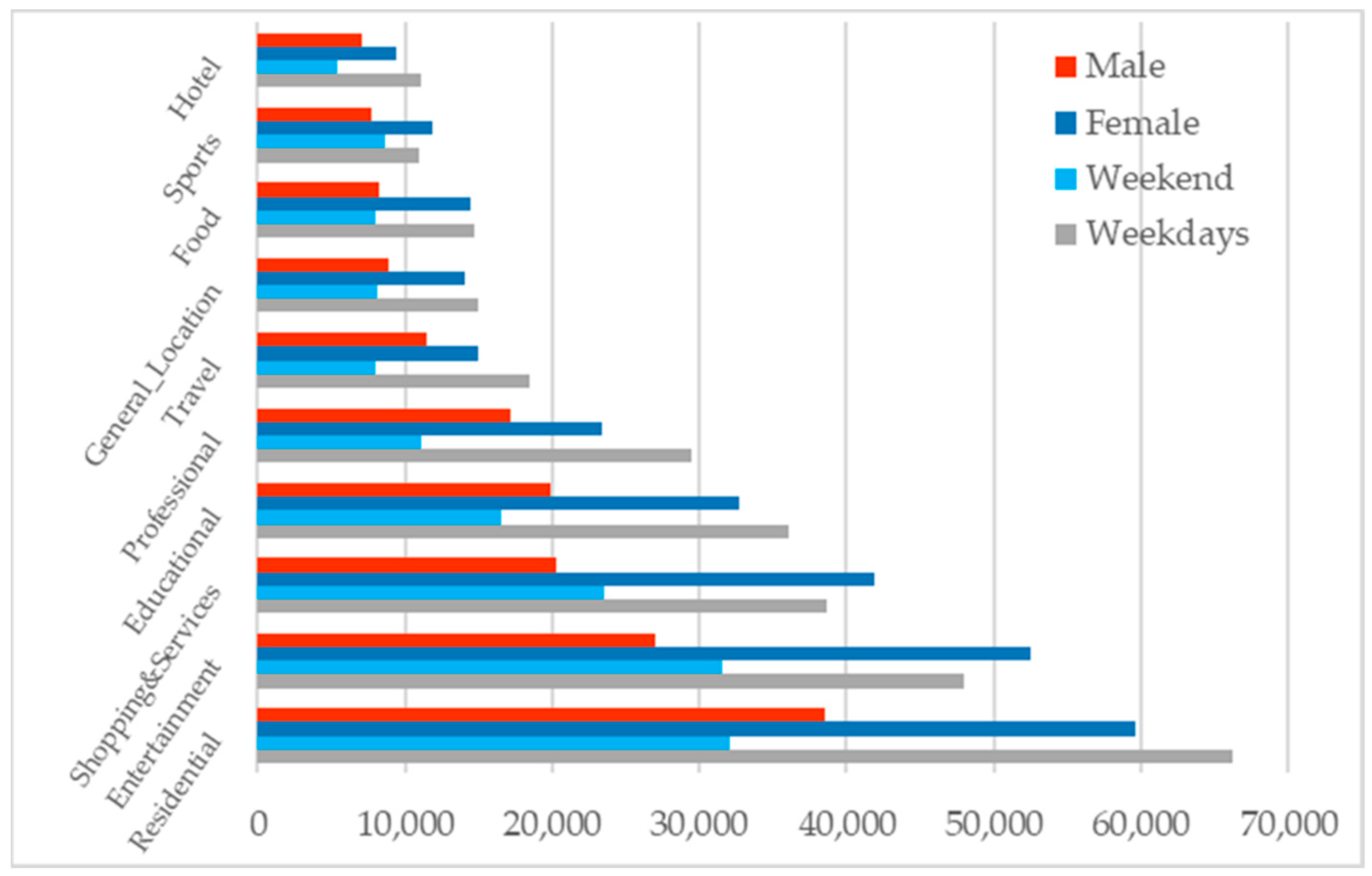
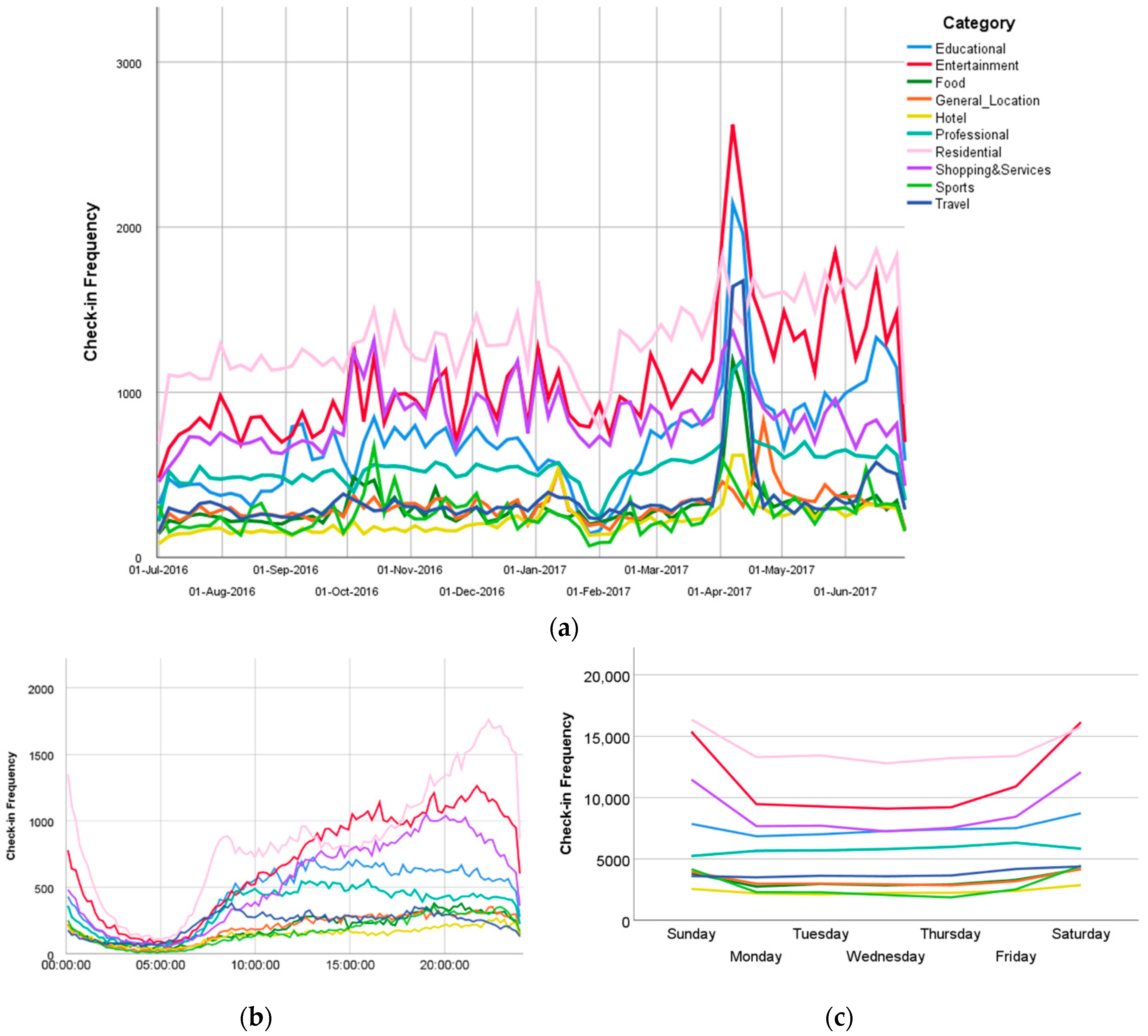
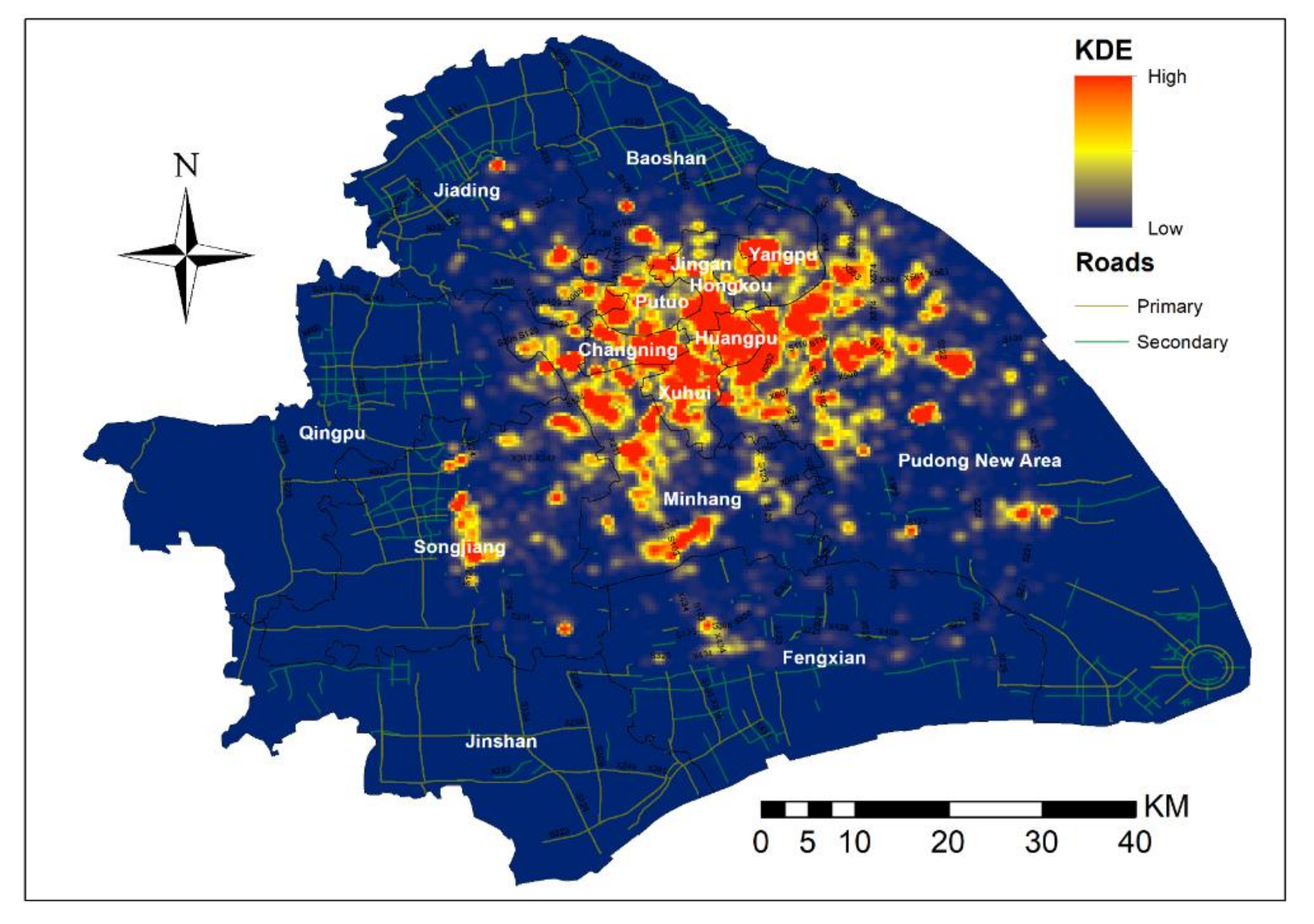
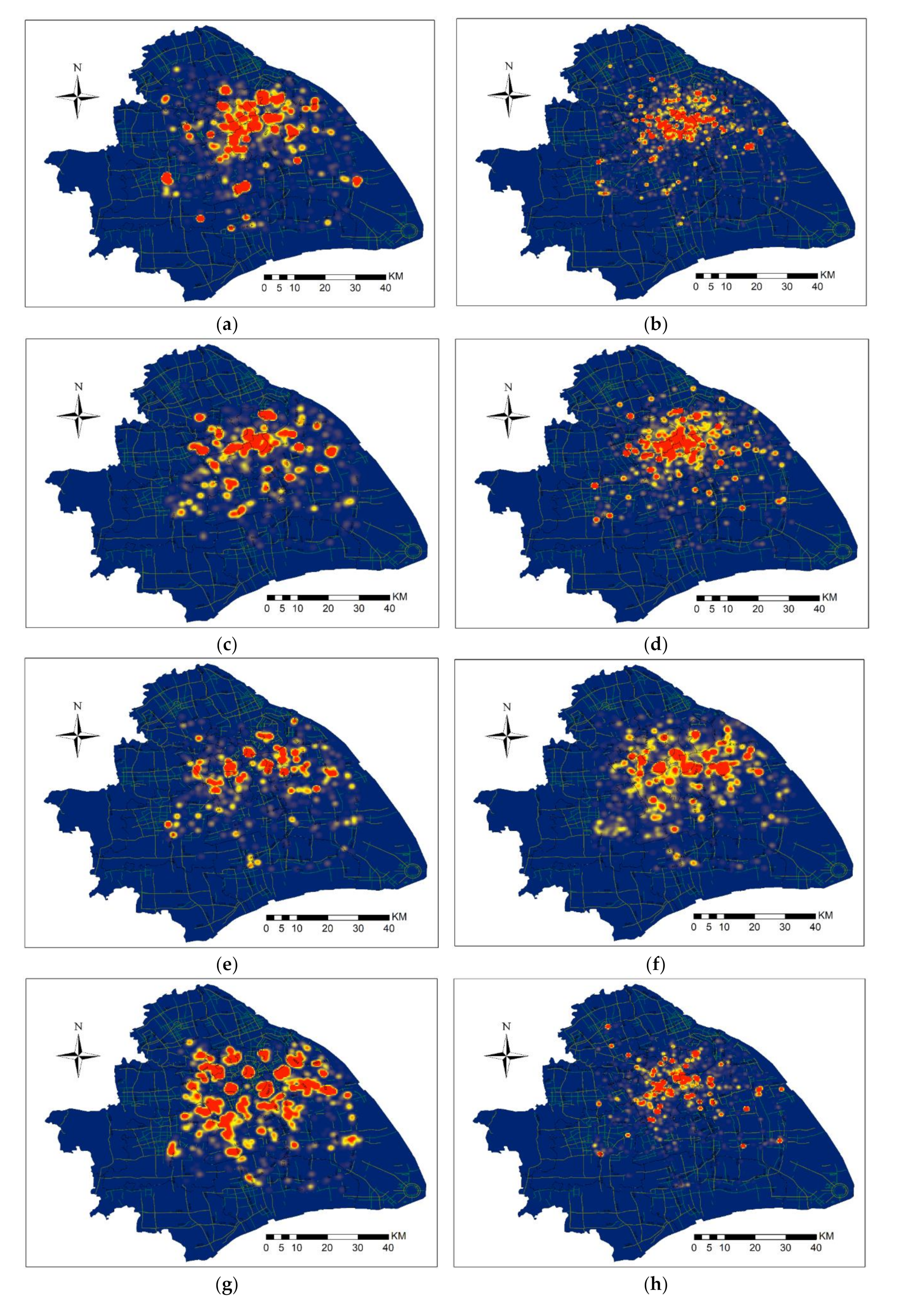

| User ID | Gender | Check-in Date | Check-in Time | Location-ID | Latitude | Longitude | Location |
|---|---|---|---|---|---|---|---|
| 56xxx20 | f | 5/8/2017 | 2:23:12 | B2xxx9A | 31.29164 | 121.31098 | Nanxiang_Hospital |
| 16xxx62 | m | 4/27/2017 | 12:17:47 | B2xxx93 | 31.314793 | 121.45629 | Lingnan_Park |
| 34xxx42 | f | 8/16/2016 | 15:44:45 | B2xxx9B | 31.281199 | 121.507732 | Siping_Cinema |
| 15xxx44 | m | 1/2/2017 | 15:22:32 | B2xxx98 | 31.28861 | 121.537 | Yanji_Library |
| Category | Number of Locations | % | Total Check-ins | Average Check-ins by Location | Gender | Total Number of Users | |
|---|---|---|---|---|---|---|---|
| Female | Male | ||||||
| Educational | 2535 | 12% | 52,645 | 20.76726 | 11,948 | 6955 | 18,902 |
| Entertainment | 2547 | 19% | 79,471 | 31.20181 | 16,750 | 7964 | 24,714 |
| Food | 2675 | 4% | 22,747 | 8.503551 | 3235 | 1746 | 4981 |
| General_Location | 1119 | 8% | 23,033 | 20.58356 | 5280 | 3084 | 8364 |
| Hotel | 1101 | 4% | 16,568 | 15.04814 | 3189 | 2523 | 5712 |
| Professional | 3030 | 7% | 40,527 | 13.37525 | 7760 | 5264 | 13,024 |
| Residential | 2945 | 24% | 98,221 | 33.35178 | 19,491 | 11,919 | 31,410 |
| Shopping & Services | 2263 | 12% | 62,155 | 27.46575 | 16,494 | 7310 | 23,804 |
| Sports | 594 | 4% | 19,590 | 32.9798 | 3309 | 3165 | 5474 |
| Travel | 1362 | 7% | 26,514 | 19.46696 | 4728 | 3469 | 8197 |
Publisher’s Note: MDPI stays neutral with regard to jurisdictional claims in published maps and institutional affiliations. |
© 2020 by the authors. Licensee MDPI, Basel, Switzerland. This article is an open access article distributed under the terms and conditions of the Creative Commons Attribution (CC BY) license (http://creativecommons.org/licenses/by/4.0/).
Share and Cite
Khan, N.U.; Wan, W.; Yu, S.; Muzahid, A.A.M.; Khan, S.; Hou, L. A Study of User Activity Patterns and the Effect of Venue Types on City Dynamics Using Location-Based Social Network Data. ISPRS Int. J. Geo-Inf. 2020, 9, 733. https://0-doi-org.brum.beds.ac.uk/10.3390/ijgi9120733
Khan NU, Wan W, Yu S, Muzahid AAM, Khan S, Hou L. A Study of User Activity Patterns and the Effect of Venue Types on City Dynamics Using Location-Based Social Network Data. ISPRS International Journal of Geo-Information. 2020; 9(12):733. https://0-doi-org.brum.beds.ac.uk/10.3390/ijgi9120733
Chicago/Turabian StyleKhan, Naimat Ullah, Wanggen Wan, Shui Yu, A. A. M. Muzahid, Sajid Khan, and Li Hou. 2020. "A Study of User Activity Patterns and the Effect of Venue Types on City Dynamics Using Location-Based Social Network Data" ISPRS International Journal of Geo-Information 9, no. 12: 733. https://0-doi-org.brum.beds.ac.uk/10.3390/ijgi9120733




